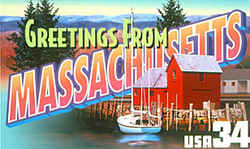
Massachusetts Symbols
Massachusetts State Glacial Rock
Rolling Rock

Adopted on August 4, 2008
On August 4, 2008, Rolling Rock located in the city of Fall River became the state glacial rock of the Commonwealth. The sought-after designation started with a group of 21 Wixon School students who participated in an after school program focusing on the geology of the Rolling Rock and the legislative process, with the intent of bestowing the official moniker on the giant boulder that sits near the intersection of County Street and Eastern Avenue. State Rep. David Sullivan petition for legislation to designate the glacial rock located in the city of Fall River as the glacial rock of the Commonwealth. To gain House approval, five students joined teacher Rebecca Cusick on July 9 for a trip to Beacon Hill. During their visit Wixon and the students shared their expertise with the Joint Committee on State Administration and Regulatory Oversight, who lent their approval to the suggestion.
"I believe that this project embodies what the educational mission in the commonwealth strives to achieve,"Sullivan said. "In addition to affirming the historical and geological significance of Rolling Rock to Fall River and to the commonwealth, we, as legislators, should recognize these students for their initiative, their academic curiosity, and their commitment and dedication to seeing the project through to its conclusion...."
Massachusetts State Glacial Rock: Rolling Rock

In Fall River, and at a green traffic island along US
Route 6, is Rolling Rock, an erratic rounded rock set on a rock base of a different type of rock.
The rock is located at the intersection of US Route 6 (Eastern Ave) and County Street, on the left side as you go south, or straight
ahead if you are traveling on County Street from Fall River Center (west). Also at this intersection is a statue of General Lafayette on a horse on
the right side as you proceed south. Park on Eastern Ave.
ROLLING ROCK has been an object of great interest for many years. It is a large boulder located at the end of the Bedford Street line. The city
recently acquired the land on which it rests, converting it into a small park. Until a short time ago, this huge rock, weighing possibly 15 tons, could
be moved with ease by a child, but it is now immovable because of the stones and sand which have collected around it.
The rock is about 140 tons in weight. It is a conglomerate stone, probably originating in the nearby town of Dighton, set on a base of granite. Legend
has it that Native American Indians had tortured or punished people by placing limbs under the rock and rolling the rock over them. From the 1840s,
geologist Hithcock was concerned that activity at a local quarry might affect the balance. The quarry man shimmed the rock to stabilize the rock (but
it doesn't rock anymore). At the turn of the 20th century, the rock was further threatened by a project to widen the road. After 25 years, the rock
was preserved by the city in 1930.
Massachusetts Law
The law designating the Rolling Rock, located in the city of Fall River as the official Massachusetts state glacial rock is found in the General Laws of Massachusetts, Part 1, Title 1, Chapter 2, Section 59
PART I ADMINISTRATION OF THE GOVERNMENT
TITLE I JURISDICTION AND EMBLEMS OF THE COMMONWEALTH, THE GENERAL COURT, STATUTES AND PUBLIC DOCUMENTS
CHAPTER 2 ARMS, GREAT SEAL AND OTHER EMBLEMS OF THE COMMONWEALTH
Section 59 Glacial rock of the commonwealth
Section 59. Rolling Rock, located in the city of Fall River, shall be the glacial rock of the commonwealth.







